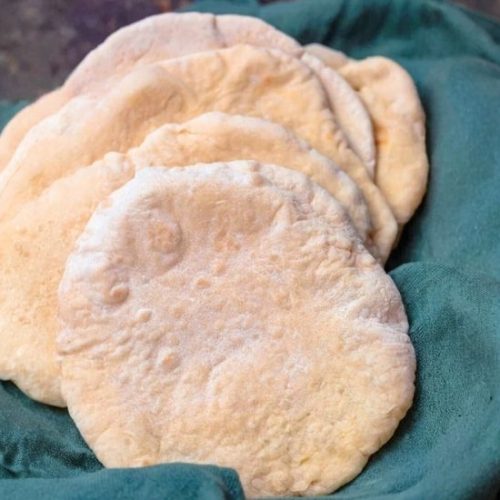
Pita Bread
This foolproof homemade pita bread recipe yields soft, airy pitas with a perfect pocket and a slightly chewy texture. Made with pantry staples like flour, yeast, and olive oil, it’s a simple, authentic recipe that brings the taste of the Mediterranean to your kitchen. Whether baked or pan-cooked, the results are warm, fresh, and better than store-bought. Great for wraps, sandwiches, or serving with dips, this recipe is also meal-prep friendly and customizable to dietary needs.
Equipment
- 1 Large Mixing Bowl – For creating sponge and kneading dough
- 1 Plastic Wrap & Kitchen Towel – For covering dough during rising
- 1 Cast Iron Skillet or Heavy Baking Sheet – For cooking or baking pitas
- 1 Rolling Pin – For flattening dough to uniform thickness
- 1 Dough Scraper – To divide and shape dough pieces
- 1 Measuring Cups and Spoons Set – For accurate ingredient portions
- 1 Spatula or Tongs – For flipping pitas on the stovetop
Ingredients
- 1 cup lukewarm water
- 2 teaspoons active dry yeast
- ½ teaspoon granulated sugar
- 3 cups all-purpose flour divided
- Optionally: use 1½ cups all-purpose flour + 1½ cups whole wheat flour for a heartier texture
- 1 to 2 teaspoons kosher salt such as Diamond Crystal
- 2 tablespoons extra virgin olive oil plus extra for greasing
Instructions
- Activate the Yeast: In a large bowl, combine the lukewarm water, yeast, and sugar. Stir gently until dissolved. Add ½ cup of the flour and whisk to create a smooth, thin batter. Let this mixture sit uncovered in a warm spot for 15 minutes. You should see bubbles forming—this is your starter “sponge” coming to life.
- Form a Soft Dough: Add the salt, olive oil, and most of the remaining flour (reserve about ½ cup for kneading and dusting). Stir with a wooden spoon until the dough comes together into a sticky, shaggy mass. Lightly sprinkle with flour and knead it in the bowl for about 1 minute to gather any loose pieces.
- Knead Until Smooth: Transfer the dough to a floured work surface. Knead for 2–3 minutes until it feels smoother. Cover loosely and let it rest for 10 minutes. Then knead again for another 2–3 minutes. The dough should be slightly tacky but manageable—dust with a little flour if needed, but avoid over-flouring.
- Allow to Rise: Wipe the mixing bowl clean and coat the inside lightly with olive oil. Place the dough back in, turning it to coat all sides in oil. Cover tightly with plastic wrap and then drape a towel over the bowl. Let it rise in a warm place until doubled in size, about 1 hour.
- Divide and Rest: Gently deflate the dough and transfer it to a clean surface. Divide into 7 or 8 equal portions and shape into balls. Cover with a clean kitchen towel and let rest for about 10 minutes to relax the gluten.
- Roll into Flat Discs: Using a lightly floured rolling pin, roll each dough ball into a circle roughly 8–9 inches in diameter and ¼-inch thick. Rotate the dough as you roll to prevent sticking. If the dough resists and springs back, let it rest a few minutes before continuing.
- Bake or Cook the Pitas: Option A – Oven Method: Preheat the oven to 475°F. Place a heavy baking sheet or cast iron pan inside to heat as well. When hot, place 1–2 pitas at a time directly onto the surface. Bake for 2 minutes, flip, then bake for 1 more minute until puffed and golden. Remove and cover with a clean towel.
- Option B – Stovetop Method: Preheat a cast iron skillet over medium-high heat. Lightly brush with olive oil and wipe away the excess. Place one pita at a time into the pan. Cook for 30 seconds until bubbles form, then flip. Cook for 1–2 minutes per side until puffed and lightly browned. Keep cooked pitas wrapped in a towel to stay warm and soft.
Notes
- Make-Ahead Tip: You can prepare the dough in advance. After the initial rise, store it in the fridge, covered, for up to 1 week. Use as needed—bake one or two pitas at a time if desired.
- Whole Wheat Variation: For a nuttier, fiber-rich version, replace half the flour with whole wheat flour (1½ cups of each).
- Gluten-Free Adaptation: Substitute with a 1-to-1 gluten-free flour blend, such as Bob’s Red Mill Gluten-Free All-Purpose or 1:1 Baking Flour. Results may vary slightly, but it works well with proper heat.
- Storage & Freezing: Fresh pita is best warm, but leftovers can be stored in a sealed bag for up to 3 days. Reheat in a toaster, oven, or over an open flame. Freeze baked pitas for up to 3 months—reheat straight from frozen.
- Why Pitas Don’t Puff: Occasionally, a pita may not form a pocket. This is normal and still delicious! Ensuring high heat and evenly rolled dough helps maximize puffing success.